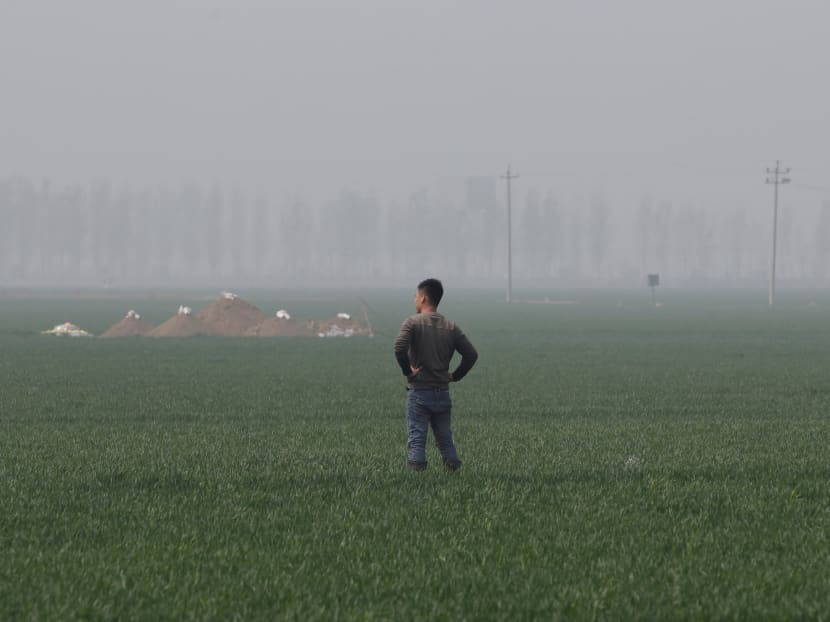Xi’s grandiose urban ambitions hit the wall
Ever since the first emperor created an enormous army of terracotta warriors to guard his tomb for eternity, Chinese leaders have been obsessed with grandiose gestures and giant monuments. There was the Great Wall, a multi-dynasty project that failed to keep the barbarian hordes at bay, and more recently Mao Zedong’s “great leap forward” economic plan, which resulted in the worst man-made famine in history.

A man stands next to tombs in the field on the outskirts of Rongcheng county, one part of the new special economic zone Xiong'an New Area, Hebei province, China, April 6, 2017. Picture taken on April 6, 2017. Photo: REUTERS
Ever since the first emperor created an enormous army of terracotta warriors to guard his tomb for eternity, Chinese leaders have been obsessed with grandiose gestures and giant monuments. There was the Great Wall, a multi-dynasty project that failed to keep the barbarian hordes at bay, and more recently Mao Zedong’s “great leap forward” economic plan, which resulted in the worst man-made famine in history.
In comparison with these, Chinese President Xi Jinping’s plan to turn a swampy backwater into a “green, innovative, world-class” city twice the size of Hong Kong and nearly three times the size of New York City seems modest. Announced on April 1, the plan to create “Xiongan New Area” was heralded by China’s tightly controlled state media as a “grand strategy to last a millennium” and a “great national endeavour”.
One sycophantic commentator even gushed that “Xiongan will show how socialism operates in building a unique, modern metropolis . . . free of the problems encountered by most capitalist communities”.
That may be going a little far: the new city is certain to be a wonder of state-directed central planning and a testament to the paucity of imagination among the country’s economic apparatchiks.
It has been three-and-a-half years since the Communist party unveiled its blueprint for economic reforms and most of those have not even started.
In apparent frustration, Mr Xi has opted for the grand gesture.
Defenders of the Xiongan plan point to the special economic zone of Shenzhen, which in the early 1980s was a collection of small fishing villages but is now one of China’s four largest and most prosperous cities. They also point to Pudong, the area just across the river from old Shanghai, transformed from a sleepy suburb in the early 1990s to today’s sparkling financial district of China’s biggest and richest city.
But for every Shenzhen and Pudong there are a dozen failed attempts to create cities out of nothing. Take Yujiapu, a desolate stretch of salt flats on the far outskirts of Tianjin, the historic port city that serves as a gateway to Beijing. Yujiapu has been marketed by ambitious officials as the “Wall Street of northern China”. After years of stop-start construction the area remains nothing more than a collection of unfinished skyscrapers. It is almost certainly a giant non-performing loan waiting to be acknowledged on the balance sheets of the state banks that paid for it.
Special economic zones are just not that special in China these days. The spectacular success of Shenzhen was in large part due to the sliver of free market capitalism it introduced to a country still destitute after decades of Maoist political terror. Even Pudong, which took a lot longer to get off the ground, offered real policy advantages to investors in the form of tax breaks and incentives.
Today there are two dozen national-level SEZs, many more “free trade zones” and thousands of provincial and local-level SEZs dotted around the country. The main incentive on offer in Xiongan appears to be the chance to ingratiate yourself with the regime by contributing to the emperor’s pet project. Shenzhen’s location just across the border from the wealthy former-British colony of Hong Kong and Pudong’s proximity to the historic commercial centre of Shanghai were also crucial.
Xiongan is more than 100km from downtown Beijing in rural Hebei province. It does not have a port or any natural advantages and has never been a centre for commerce or enterprise.
Perhaps the most crucial ingredient in the success of earlier economic zones was the steady flow of foreign investment that brought with it technology, know-how and advanced commercial practices. But Mr Xi and his underlings have explicitly ruled out significant foreign involvement in Xiongan. Analysts at UBS estimate that up to US$580 billion — roughly the gross domestic product of Argentina — could be spent on building Xiongan over the next two decades. Most of this will again be paid for by state banks despite the country’s soaring debt load.
The immediate response to Mr Xi’s Xiongan plan was as predictable as it was farcical — property prices in the area tripled overnight before the government banned property sales, shut down 71 real estate agents and arrested seven people for unspecified “real estate violations”.
Then, in a move that would have been unnecessary in the time of the terracotta army or the Great Wall, the Communist party issued an order to its army of internet censors: all criticism and negative commentary about the Xiongan New Area must be deleted immediately. THE FINANCIAL TIMES
* Jamil Anderlini is Asia Editor at The Financial Times.






